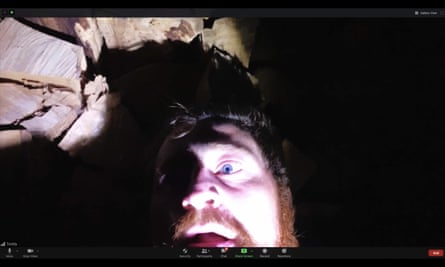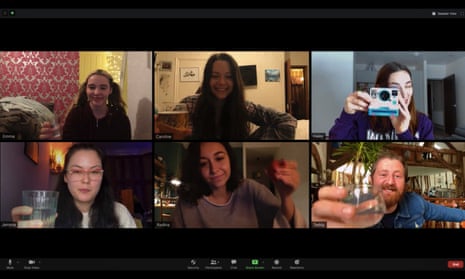It will make you jump, shriek and come up close to one of the most dreaded elements of quarantine: the group Zoom call. Now Host, the tiny British horror film conceived and made in lockdown, is being hailed as the first great film of the pandemic.
Its writers – Rob Savage, Jed Shepherd and Gemma Hurley – have fashioned a chilling 57-minute movie from a two-word text sent by Shepherd to Savage at 4.34am on 24 April. It simply read: ‘Zoom seance’. A group of six friends get together on the video conference call platform and, with the help of a medium who – of course – loses her internet connection early on, they call up the spirits.
What began as a prank borne from a WhatsApp quarantine film club with real-life friends ended up the subject of a studio bidding war. The finished result, which premiered on horror channel Shudder a fortnight ago, has created a viral sensation online. Cast and crew have been interviewed by breakfast TV in the US. A UK cinematic release is on the way. Evil Dead creator Sam Raimi has signed up to produce Savage and Shepherd’s next project.
How did it all come about? “Lockdown boredom,” says Savage over Zoom (of course), joined by Shepherd, producer Douglas Cox and cast members Haley Bishop and Radina Drandova. “Everyone who made the movie in front of and behind the camera, they were the friends that I was on Zoom with doing happy hours, quizzes, all that stuff, and I wanted to find a way to scare them.”
Savage, who has directed multiple award-winning horror shorts, filmed himself while on one of those Zoom calls heading into his spooky attic. He managed to splice his footage with a zombie horror movie in what seemed like real time and freak out the group, who were left stunned. Within hours of being posted on Twitter, the clip had been viewed several million times. Interest from the film industry for a developed feature was so high that the team committed to creating and delivering a proper film, made and directed virtually, all within 12 weeks.
I’ve been hearing strange noises from my attic, so I called a few friends and went to investigate… pic.twitter.com/CxmJAf44ob
— Rob Savage (@DirRobSavage) April 21, 2020
“We didn’t waste our time in lockdown just baking sourdough and banana bread,” says Shepherd, “which is fine. People need to eat! But it’s cool for me in years to come, when you look at this crazy time in history, we can point to [Host] and say ‘this is what we did with our friends’. Something we wanted to have watched and that everyone else really liked.”
Savage and Shepherd have been taken aback at the buzz, which has transcended the genre fans they were aiming for. A review in the New York Times said the film “speaks to a moment of uncertainty… As we sit at home with the devices that promised us limitless possibilities in our hands, Host identifies the uncomfortable in-between state we exist in, operating ghostlike.”
“It’s really surprising how it’s expanded from being the horror audience embracing it,” says Savage. “It’s also weird that we started this by hanging out on Zoom in lockdown, we made a film through Zoom in lockdown, and we’ve released it in lockdown and this is still our reality. We’re not leaving the house, so it feels really disjointed and strange and not quite real yet. And I’m still spending way too much time on Zoom.”

Actors were not given full scripts so did not know what happened to one another until they saw the action unfold. They also had to make their own blood, do their own makeup and rig their own homes to accommodate the five-day shoot. Smoke pellets were tested in the local park before Drandova dared set one off at home; Bishop repurposed a bag of ropes she had previously told her boyfriend to throw away. “Luckily he didn’t, and look who’s laughing now,” she says.
It’s an extraordinary effort that has arguably shifted the language of film-making a notch. Despite its seemingly lo-fi stakes, the film is packed with scares, stunts and special effects that are the subject of countless internet threads and blogs trying to work them out.
“There is this idea of the director as the author, but this film belongs to all of us,” says Savage. “Everyone was throwing in ideas, everyone was figuring it out as we went along, doing their own stunts, being their own one-person film production. The more you can encourage that group endeavour, the better the end result. It’s definitely something I’ll take to whatever I do after this.”
